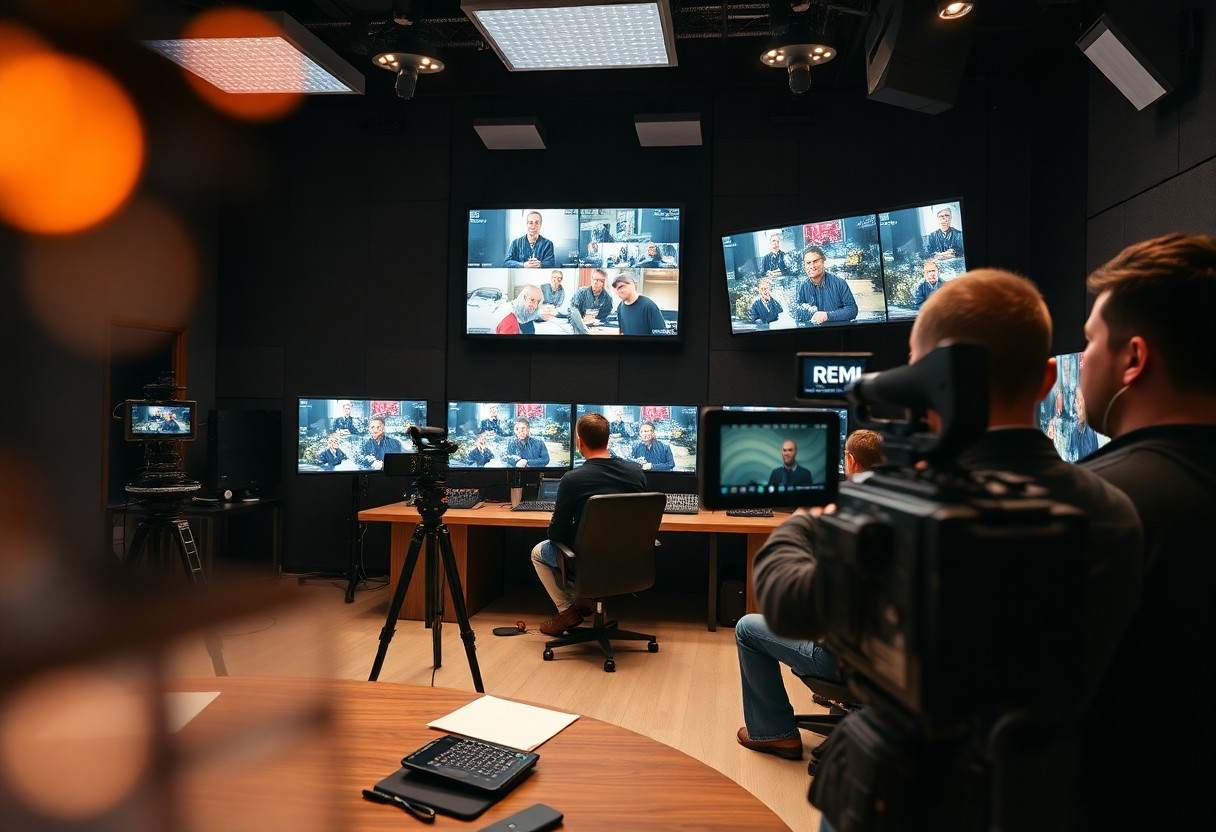Most industry professionals agree that remote video production is experiencing a significant transformation, thanks to innovative REMI technology. As you explore this evolving landscape, you’ll discover how these advancements are streamlining workflows, enhancing creativity, and reducing costs. If you want to stay ahead of the curve, it’s imperative to understand the implications of these changes, as highlighted in the Future Of Remote Production Comes Into Focus During the TV Tech Summit. By embracing REMI, you can elevate your production capabilities and adapt to the demands of a rapidly changing media environment.
Understanding REMI Technology
As you examine into the world of remote video production, it becomes imperative to grasp the significance of REMI technology. This innovative method allows you to produce high-quality live broadcasts without being tethered to traditional on-site setups. By utilizing a mix of local and remote resources, it streamlines the production process and opens up new possibilities for content creators.
Definition of REMI
Across the broadcasting landscape, REMI, or Remote Integration Model, leverages cutting-edge technology to facilitate video production from a distance. This model allows you to utilize remote locations for capturing video while maintaining control over the production process, often hosted in centralized studios. It effectively reduces costs while enhancing flexibility in your productions.
Key Features and Advantages
Below are some key features and advantages that make REMI technology a game changer in video production:
- Reduced travel and accommodation costs.
- High-quality production from multiple locations.
- Real-time editing and graphics integration.
- Scalability to meet different project needs.
- Improved collaboration among production teams.
Assume that you’re considering how to incorporate REMI into your workflow, you’ll find that these features significantly enhance your production capabilities.
Indeed, the key advantages of REMI technology are transforming how you approach video production. With its blend of flexibility and efficiency, you can streamline your workflows to adapt to varying project demands. This technology allows you to maximize your resources and maintain a high level of production quality, ultimately leading to a more successful outcome. Here are additional key features to consider:
- Cost-effective operational models.
- Access to a wider talent pool.
- Enhanced viewer engagement through innovation.
- Lower environmental impact due to reduced travel.
- Simplified logistics for complex projects.
Assume that leveraging these advantages can set you apart in the competitive landscape of video production.
The Impact of REMI on Video Production
It is necessary to understand how REMI technology is shaping the landscape of video production. With its ability to streamline processes and enhance output quality, REMI is emerging as a game-changer in the industry. For more insights, check out Remote Production: Revolutionizing the Broadcast Industry.
Cost Efficiency
Across various production environments, REMI technology significantly reduces costs by minimizing travel expenses, equipment rentals, and on-site personnel requirements. By allowing teams to produce high-quality content remotely, you can allocate your budget more effectively, ensuring better resource management and higher returns on investment.
Enhanced Collaboration
Below the surface, REMI fosters an environment where your team can collaborate seamlessly, regardless of their physical locations. This advancement enables real-time communication, input sharing, and collective creativity, enhancing the overall production process. With tools designed for effective coordination, team members can contribute more efficiently, leading to superior results.
Collaboration becomes effortless when you harness REMI tools that integrate video feeds, audio components, and communication platforms in one cohesive system. This allows you and your team to exchange ideas, provide instant feedback, and make adjustments in real time, ultimately improving the quality of the finished product. Your projects can benefit from diverse input, driving innovation and enhancing creative workflows through enhanced teamwork and communication.
Case Studies of REMI in Action
Clearly, the impact of REMI technology in remote video production can be illustrated through several compelling case studies:
- ESPN reported a 30% reduction in production costs for live events using REMI technology.
- Fox Sports achieved a 25% faster turnaround time for post-production workflows.
- NHL utilized REMI for over 160 games in a single season, ensuring broad coverage without significant travel expenses.
- Local news stations have recorded a 40% increase in viewer engagement when implementing REMI for remote broadcasts.
For an in-depth analysis, check out A Decade of REMI at ESPN – An Inside Look at the Past ….
Live Events
After examining the implementation of REMI technology at live events, you’ll find that it has transformed how productions are organized. By centralizing control into a remote location, teams can respond to unexpected challenges quickly while maintaining high production quality.
Broadcast Industry
To understand REMI’s role in the broadcast industry, you need to recognize how it facilitates more efficient workflows. With remote capabilities, teams can collaborate in real-time, leading to innovative content creation and better audience engagement.
The evolution of the broadcast industry owes much to REMI technology, allowing broadcasters to stretch their capabilities without the need for extensive infrastructure. As producers and directors, you can now cover multiple events simultaneously with ease, making it possible to react quickly to viewer demands and enhance your overall broadcasting strategy.
Future Trends in Remote Video Production
Unlike traditional video production, where on-site presence is paramount, remote production embraces flexibility and adaptability. As you explore the landscape of remote video production, you’ll find that collaboration tools, cloud technology, and high-speed connectivity will drive significant changes. The industry is evolving to offer enhanced opportunities for content creators and organizations, making it important for you to stay updated on these transformative trends.
Emerging Technologies
Future advancements in AI, 5G connectivity, and virtual reality are set to revolutionize remote video production. As you leverage these emerging technologies, you’ll be able to enhance your production quality, streamline workflows, and engage audiences in innovative ways. The integration of these tools will enable improved collaboration among teams, regardless of geographical location, ensuring your projects remain competitive and cutting-edge.
Predictions for the Industry
Technologies in remote video production are expected to progress rapidly, with AI-driven tools becoming more prevalent in workflow automation and content generation. By utilizing these advancements, you will likely enhance productivity, reduce costs, and create more captivating content. The democratization of video production tools is also forecasted to increase access for aspiring creators, allowing you to tap into new talent pools and diverse perspectives.
At the forefront of these predictions, the shift toward virtual events and hybrid formats is anticipated to reshape your approach to video production. You can expect an increase in demand for seamless integration of live and pre-produced content, pushing your creative boundaries. Enhanced data analytics and insights will empower you to make informed decisions, tailoring your content for maximum engagement. As you navigate these changes, keeping abreast of industry trends will be key to your success in a rapidly evolving landscape.
Challenges and Considerations
For those venturing into remote video production, navigating various challenges and considerations is vital. You need to be aware of the technological demands, the need for reliable setups, and the potential pitfalls that can arise from working in a distributed environment. Each of these factors can significantly impact your production quality and efficiency, making it necessary to develop strategies to address them effectively.
Technical Challenges
Above all, technical challenges encompass the complexities of connectivity, bandwidth limitations, and the compatibility of different devices. You might find yourself grappling with latency issues, dropped connections, or mismatched software that disrupt your workflow. It’s imperative to invest time in setting up a solid technological foundation to ensure seamless production processes.
Security and Privacy Concerns
Across the remote production landscape, security and privacy concerns loom large as you transmit sensitive content over the internet. Protecting your intellectual property and personal data from breaches is paramount, particularly in a world where cyber threats are constantly evolving.
This requires you to implement robust security protocols, including encryption and secure access controls, to safeguard your projects. Additionally, be mindful of contracts and agreements when collaborating with external teams, as you must ensure that all parties understand and adhere to your security standards. By prioritizing these measures, you can create a more secure environment for your remote video production endeavors.
Best Practices for Implementing REMI Technology
Not only is REMI technology transforming remote video production, but effectively implementing it requires adhering to best practices. Start by assessing your team’s current skills and identify areas for improvement. This will ensure your team is well-prepared and confident to embrace this innovative technology, resulting in more efficient workflows and enhanced output quality.
Preparing Your Team
Any successful transition to REMI technology begins with proper training and preparation of your team. It’s important that everyone understands the new workflows and tools involved in remote production. Providing engaging training sessions and clear documentation will empower your team to fully leverage the advantages of REMI systems.
Choosing the Right Equipment
Preparing to implement REMI technology involves selecting the most suitable equipment for your production needs. Consider factors such as compatibility with existing systems, ease of use, and the ability to scale as your production requirements grow.
Understanding the diverse equipment options available for REMI setups is vital in ensuring a successful implementation. Focus on cameras, audio equipment, and network infrastructure that facilitate high-quality streaming and seamless integration with your production software. Additionally, consider the technical support and warranties provided by manufacturers, as these factors can impact your overall satisfaction and performance in live production environments.
Summing up
As a reminder, the future of remote video production is being transformed by REMI technology, offering you enhanced flexibility and cost-efficiency. By using this innovative approach, you can streamline your production processes without sacrificing quality. As you adapt to these advancements, your ability to deliver high-quality content from remote locations will elevate, allowing you to stay competitive and responsive in the ever-evolving media landscape.




